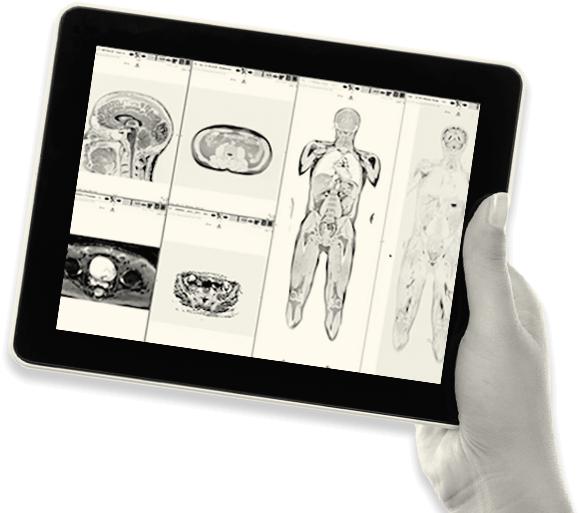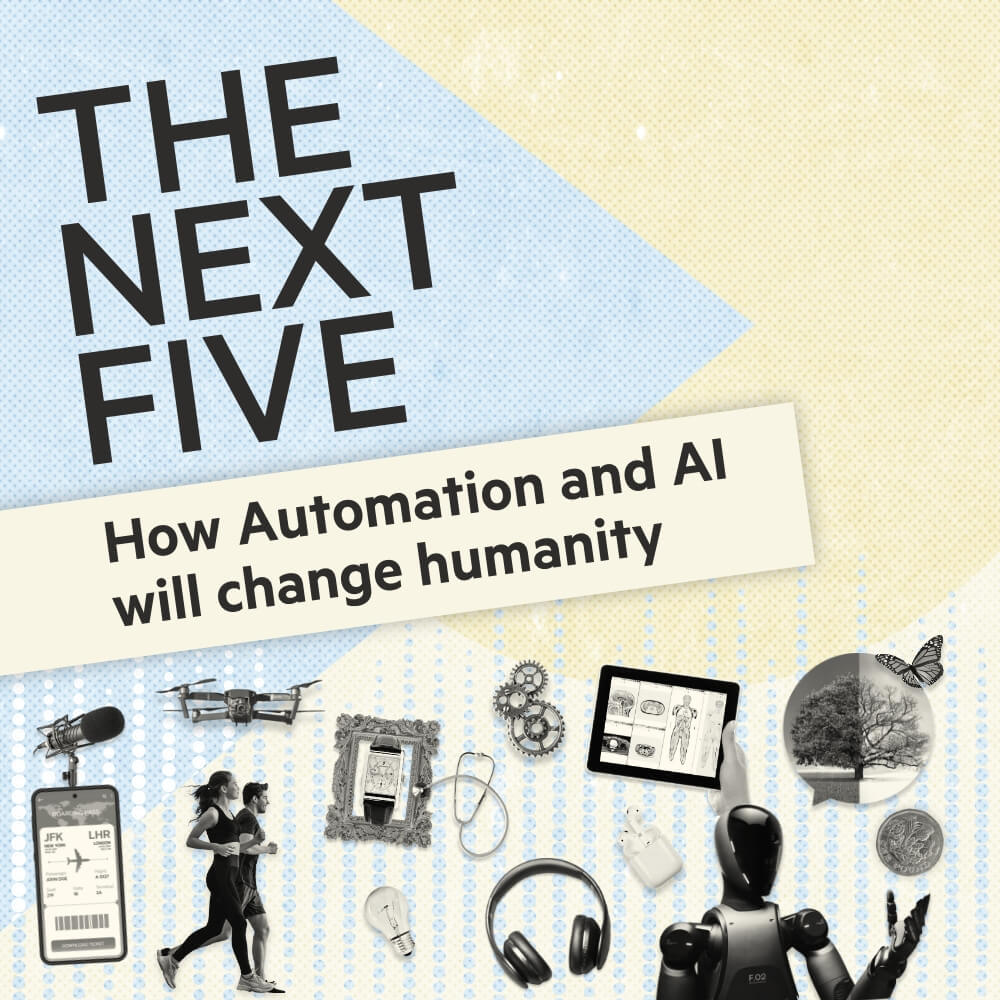THE NEXT FIVE
THE NEXT FIVE - EPISODE 8
The Digital Office
Experimental packaging to digital twin technology: listen to why sustainability must be centre stage for supply chains






































The Next Five is the FT’s partner-supported podcast, exploring the future of industries through expert insights and thought-provoking discussions with host, Tom Parker. Each episode brings together leading voices to analyse the trends, innovations, challenges and opportunities shaping the next five years in business, geo politics, technology, health and lifestyle.
















Featured in this episode:
Tom Parker
Executive Producer & Presenter
Sheela Subramanian
Founder of Future Forum and VP at Slack
Dennis P. Stolle, JD, PhD
Senior Director of Applied Psychology, for the American Psychological Association
Vladimir Lukic
Managing Director & Senior Partner; Global Leader, Tech and Digital Advantage, Boston Consulting Group
From WFH to WFA: How technology is allowing the modern workforce to work where and when they want
The way we work has changed since the pandemic. The modern workforce now, more than ever before, enjoys flexibility in where and when they work. But businesses, leaders and employees are still experimenting with how best to work. In this episode of The Next Five we explore the shifting sands of desk based work, looking at the effect of technology on traditional structures, employee productivity, communication and wellbeing, and ask how the technology led digital HQ might help solve some of the current challenges. Sheela Subramanian, Founder of Future Forum and VP at Slack, shows us how business leaders and companies can build a flexible, productive digital workforce that puts employees at the centre of the strategy. Dennis P. Stolle, JD, PhD and Senior Director of Applied Psychology, for the American Psychological Association offers insight into employee wellbeing and how digital first approach to working can benefit a workforce and the role that technology play a part. Vladimir Lukic, Managing Director & Senior Partner; Global Leader, Tech and Digital Advantage, Boston Consulting Group also extols the benefits of technology in helping business growth and discusses how business leaders can scale in a new digitally led world.
Our Sources for the show: FT Resources, Mckinsey, Randstad Work Monitor, KCL, G&A Partners. This content is paid for by Slack and is produced in partnership with the Financial Times' Commercial Department.
READ TRANSCRIPT
- Tech
- Lifestyle
- Climate
Transcript
The Digital Office
Tom intro
00:22
IN AN ECONOMY WHERE UNEMPLOYMENT IS LOW Employees have more power
Tom Parker 00:25 “The last two and a half years have delivered the greatest changes to office work in generations, leaving employees greater choice than ever
DENNIS - 00:53
“Generally speaking, the data suggests that employees thrive when they get to choose both where they work, and how they work.
Tom Parker 00:32
These changes have been made possible by the rise of remote tools that allow for collaboration regardless of location or working schedules.
Sheela - 01:21
we're in the middle of this crazy experiment that's basically changed the way that we approach work
But now
Music Fade
Tom Parker:
I'm Tom Parker, and welcome to the next five podcasts brought to you by the FT partner studio. In this series, we ask industry experts about how their world will change in the next five years, and the impact it will have on our day to day. In this episode, we will explore the shifting sands of desk-based work, looking at the effect of technology on traditional structures, employee productivity, communication and wellbeing, and ask how the technology led digital HQ might help solve some of the current challenges.
Tom Parker: 01:30 Back in 1964 Arthur C Clarke, a British science fiction author, inventor, and futurist, most famous for the novel 2001: A Space Odyssey, spoke about the technological breakthroughs in communications of the time, mainly the developments in the transistor and communications satellites. He said ‘These things make possible a world in which we can be in instant contact with each other, wherever we may be’. 02:02‘It will be possible’ he added’ in that age, perhaps 50 years from now for a man to conduct his business from Tahiti or Bali just as well as he could from London’
Tom Parker: 02:40 He’s not wrong - the technological advancements since his time has allowed us to conduct business anywhere in the world. But it took a global pandemic to really shift the way we work. Technology adapted further to allow us to maximise our potential to work independent of distance from colleagues and the office. Post pandemic, hybrid work is on the rise meaning that businesses are under pressure to adopt bolder digital strategies, and to attract, train and develop a tech-savvy workforce of the future if they are to adapt and remain successful.
So, 60 years on, what does the future look like now and how are businesses and technology adapting to allow us to work from anywhere in the world?
Soundbite:
Sheela Subramanian - 7:16
The first thing is even just defining the term flexibility.
What I think is refreshing in terms of where we are right now is that leaders are more willing to have the conversation about how to redesign work.
Tom Parker : 03:40 This is Sheela Subramanian, co-founder, Future Forum; Vice President, Slack
Sheela 07:11
There are a lot of preconceived notions about what work should look like. The first thing is even just defining the term flexibility. When we talk about flexibility, oftentimes, it's focused on where people work. And what we see is that 80% of employees want more flexibility in where they work. But what I've found more fascinating over the last three years, as we've studied this, is that 94% of people want flexibility in when they work, they want to have a bit more time during the day to live their life, as well as to do focus work.
What I think is also important to acknowledge is that we're not at the end of this experiment, we're three years in, but we're in the middle of this crazy experiment that's basically changed the way that we approach work, and the way that we think of the role of work in our lives. And so I think that there have been pushes over the last few months to return back to how things used to be. But what we're also seeing is resistance from employees who have reevaluated how work fits in their lives, and they're clear in terms of what that balance looks like for them.”
Tom Parker : 04:40
A study by King’s college London in June of 2022 showed that 75% of London workers surveyed are working from home at least one day a week, double the figures prior to the pandemic.
Tom Parker : 05:16 In the same study 80% of those who work from home one day a week said it had a positive impact on them.
A McKinzie survey found that 35 per cent of the US labour force have even more freedom: the option to work from home five days a week.
Dennis - 30:52
At APA, we have now transitioned completely to a remote first work environment.
Tom Parker: 06: 03 This is Dennis P. Stolle, JD, PhD, Senior Director of Applied Psychology, for the American Psychological Association
“Generally speaking, the data suggests that employees thrive when they get to choose both where they work, and how they work.
And it's not so much that it is the when and how a person works that causes the thriving, it's a broader concept than that. And it's a concept of autonomy. And so when employees have an appropriate amount of autonomy, that creates a circumstance where employees can thrive. And I'm careful to say an appropriate amount of autonomy, right? You can't, you can't run an organisation where you just let everybody loose, you know, going off doing their own thing. There has to be some kind of structure, there has to be some level of rules, but then baked into that there has to be an appropriate level of autonomy. And there's just no question that study after study shows that having that circumstance in place, leads to higher levels of a sense of belonging, higher levels of motivation, higher levels of productivity, higher levels of trust in the organisation, higher levels of trust in the team that they're working with. So all of that is just extremely important.
Tom Parker: 06:28
Productivity goes to the heart of future growth prospects: according to McKinsey, achieving just 1 percentage point of additional productivity growth a year in every country to 2024 would imply an increase in per-capita GDP ranging from about $1,500 in Spain to about $3,500 in the US.
So could technology and working from home help productivity?
Sheela - 40:09
What we're seeing is record levels of burnout among employees among managers, because many people feel like they always need to be on to show that they're working. I think it's really important for us to have the conversation around productivity and what it means, because productivity, historically defined as the number of hours you're spending in the office, or the number of hours that you're spending online, has always been active. And productivity is about value. It's what you're creating. It's the outcomes. And this is one of the reasons why middle managers have been struggling. They've been measuring the number of hours their employees have been working, rather than the outcomes, what good looks like for their specific teams. I think it's really important for leaders to have the conversation of what productivity means. How do you measure productivity? How do you measure the value that someone's creating, so that they know what good looks like, so then they know what good looks like and they can define their day accordingly to get there. Cal Newport recently wrote about slow productivity and basically slow productivity is giving time for people to think, to focus and to do bigger, fewer things with higher quality. And I think that continuing to have the conversation about what productivity looks like in terms of bigger fewer things? Rather than trying to do all the things will help combat burnout will also be really positive for organisations as they think about their long term business health?
Sheela - 15:32
You know, at SLACK, we've encouraged a nonlinear workday. I want to encourage leaders to continue to think about work outside of the confines of nine to five and think about measuring productivity in new ways. Because with knowledge work, historically, management productivity has been based on presenteeism, it's been based on activity tracking during my first performance review 20 years ago, it was you respond to emails at midnight, so you're doing a great job. We need to shift the conversation from activity tracking and presenteeism to your creating value and XY and Z, you are hitting your goals, you deserve to get promoted. I think that's a much more equitable and inclusive way of building the conversation around career mobility, versus you're willing to sacrifice time with your family and friends for your health in order to show that you're a hard worker.
Tom Parker: Employee wellness is an essential ingredient to success within an organisation and plays a part in productivity. According to, best-selling author, TED and keynote speaker Jacob Morgan companies with high Employee-Experience or EX scores enjoy higher average profits, and greater revenues per employee, than those where staff are unhappy.
They also suffer far less employee turnover – a factor that, according to G&A Partners, costs companies 50 per cent of an employee’s salary.
Dennis, are companies waking up to the importance of psychological wellbeing in the workplace?
Dennis - 0:49
I think that the short answer is yes, most companies are absolutely waking up to the importance of psychological well being in the workplace. I would say that the longer answer to that, though, is that the amount of engagement that I see across employers is not uniform from one employer to the next.
I'd say that on average, though, there is definitely an increased recognition. And, you know, there's a lot of survey data out there that really supports that notion, one of the surveys that that we recently did at the APA shows that among employees, their perception is that more than 70% of employees in the US think that right now their employer is paying more attention to mental health and psychological well being than what they've seen in the past. And so, you know, that's, that's a pretty substantial number.
Tom Parker: How does technology play a part? The term tech fatigue is being used more often now. Can you expand on what this is?
Dennis - 19:38
The tech fatigue is real. And again, I would say that you have to be careful about the terms because it's not the tech that's causing us to be exhausted. It's the constant working that's causing us to be exhausted. And the tech allows us to be constantly on call, so to speak or to be constantly working. And so again, we just have to be intentional about building in breaks. And there are small things that both employers and employees can do. From an employer perspective, one of the things that we have implemented at the American Psychological Association is a programme that we refer to as meet with purpose. And we have put out essentially a mandate to all employees that if you are going to schedule a 30 minute meeting, and the vast majority of our meetings are by video conference, it's not really going to be 30 minutes, you're going to schedule it to end at the 25 minute mark. So that people are not going from one meeting to the next meeting, without even the chance to get up and take a break or get a glass of water or whatever they may need to do. If it's going to be an hour meeting, that is going to end at the 50 minute mark.
Tom Parker:
So as a business you’ve redefined your approach to work, you’ve engaged with your employees as to how best to work and you’ve adopted technology to allow everyone to work better and from anywhere. What other benefits come from digitalilising your HQ that business leaders should consider?
Vlad - 3:38
Let's say you have half a million employees, right.
Tom: This is Vladimir Lukic, Managing Director & Senior Partner; Global Leader, Tech and Digital Advantage, Boston Consulting Group.
And you want to keep growing at 10-20%, right, your top line, because it's what your investors are expecting and your profits etc. You need to hire 3040 50,000 people every year, not going forward. Right. And with the turnover, call it 100,000 People, right. And so that's hard to find today, like in the US, you have 12 million open positions, and only 3 million people looking for a job. So there's like 9 million positions you can fill. So good luck hiring someone. So the only way you can actually keep growing and capturing the market is if you're deploying the technology and making the folks you have more efficient and more productive with it. Right. So within that context, the only way you can grow right at the pace that is required from the leading companies is if you're deploying technology and making your workforce more efficient
Vlad - 11:08
I would say they're a bunch of different components to get this done. So let's unpack them. Number one is being super clear about the level of ambition and what you're trying to do. It's very different if you say, we just want to digitise our business, then if you say, I want to make sure that our billion dollar business grows 20%. And all of that growth is coming from digital solutions. Are we doing something different in a digital way? Well, okay, that means I need to grow, I need to find $200 million of activity and what I'm selling, that I can tie to digital activities, some apps or solutions are some services we are now providing in a different way. Well, that's interesting, I'm now zeroing in on the problem statement, right. And then the next step is to articulate those use cases that are going to unlock the value, we're going to help you deliver that ambition. So be diligent about articulating it, and putting a number on it. So you can manage to see if you force yourself to articulate where the value is and how you're going to unlock it. And you can start measuring it because if you can measure it, a lot of the stuff is wasted. then they don't change the incentives of the people that should be using the data.
Vlad - 20:52
I would just say to all the older listeners, like hey, don't wait for silver bullets, right? The things that are going to be a black box, you just press a button and something magically happens, right? Think about it as a lot of bespoke interesting things going on. And don't wait to try things. Learn the limitations. Think about what it means for you in our day to day life or in your job? What does it mean for that in your workforce, in your workplace? And then have those conversations and feed it into your company's discussions, right? And like, then you're just going to have a point of view. And that's the most important thing in all of this so that you know both the limitations and potential and then we'll collectively figure out how to deploy.
Tom: Dennis, your thoughts?
Dennis - 14:15
Our use of technology, the advances in technology and the technology we have available to us now has been a huge benefit in multiple different ways. But it has particularly benefited certain segments of the workforce. And so for example, teams that are international benefit tremendously from the ability to get together on a regular basis through a video conferencing platform. Whereas in the past that just wasn't available to do that. Whereas now to hop on a call with your colleague who is in Singapore is just as normal as hopping on a call with your colleague who lives three miles from you, but neither one of you are in the office that day. And so it's really brought a more cohesive approach to that international work. It has also been a tremendous benefit for people who are living with disabilities, and who have a great deal of difficulty getting to an office place or manoeuvring through an office place. And it has allowed them to be a part of a team and a part of a conversation in a much more integrated way.
So employers have to be skillful about choosing the technology that is available, and investing in that technology, you know, taking, taking the dive to really put some money behind that technology, which can be a scary thing to do, because technology changes so fast. On the employees side, there's really at this point in time, a responsibility and individual responsibility to learn how to use this stuff and to make it work. If you're going to be effective in your organisation. You can't ignore technology, you have to integrate it, learn it, and be on top of it. And that's a constant process.
And so when you ask about success in this area, you know, what does success mean? And I would submit that for employers. Success does not necessarily mean that you've moved your office fully to a remote first approach. Instead, success might mean that you have thoughtfully considered what the options are, and how that's going to work for your particular business and your particular input.
Tom: Sheela have you worked with any companies in particular that are doing it right?
Sheela - 18:01
Yes, so Dropbox is an example of a company that really focused on experimentation and investing in technology and tools. So what we see from our research Future Forum is that organisations that are more forward in terms of investing in new tools and technology, they have a higher sense of belonging, higher productivity and higher overall work satisfaction among employees, investing in the right tools. And experimentation is really important in terms of building culture. And what we saw with Dropbox is that early in the pandemic, their executive team came together, and they committed to becoming virtual first. And they said, we are now a virtual first company. And we are converting our offices into studios as opportunities for people to connect and collaborate on a periodic basis. But we don't need people coming into the office every single day to show that they're working and to do solo focused work. And what we saw from the virtual first policy is that Dropbox adopted the nonlinear workday, where they basically said, we're going to anchor core team work hours against time zones. So this is when you're expected to work synchronously. This is when you're expected to work asynchronously. And that's been highly successful within the organisation. And since implementing this new approach to working, what we've seen is that Dropbox has seen a three fold increase in output applicants, a 15%, faster time to hire and a 16% increase in diverse candidates. So by embracing this virtual or digital first way of working by using tools like Slack, what they've seen is that they've been able to be really competitive in this battle for talent, because they're able to hire candidates regardless of where they're located. And they're also encouraging candidates and employees to live their lives and be effective employees. And I think that the adoption of digital tools and the intentional use of in person time has been a great case study to highlight for a company that's doing really well.
Tom: Looking ahead to the Next Five Years, what will the future of work look like? Will the Digital HQ be the norm?
Dennis 39:43
When I think about how's this going to unfold over the course of the next five years? A few things come to mind. First of all, I don't believe that we're going to move absent a new pandemic, which hopefully is not going to happen, we're not going to move in the direction where everyone is working remotely. That's just not, that's not a sensible solution. Some jobs have to be done in a physical space. And even not every office worker is going to be remote. But I think that we are going to see the workforce shifting in a direction of a remote first approach. And so the idea is, when you get a new job, you're probably going to work from home, unless you have a conversation about oh, this isn't the kind of job where I work from home. And so then, whereas in the past, if the conversation was flipped, you would expect that you're going to an office until you learned that, oh, actually, I could do this from home. So I think we're gonna see almost everything turned completely upside down in that sense. And so again, it's not a remote only approach, but it's a remote first approach. And there's still going to be times when physical gatherings in person are necessary. And it's going to be more frequent in some kinds of jobs than in others. A second thing that I think we are absolutely going to see is improvements in the technology. And I can't predict, of course, exactly what those improvements are going to be. But I just am very optimistic that when we've got huge software companies like Microsoft, on the one hand, and small startups, on the other hand, all focused on these issues, and I see them reaching out to psychologists and other social scientists and bringing them into the team, I think that we're going to see major changes on the technology front that are going to be improvements. And I'm optimistic enough to think that in five years from now, we're gonna look back and say, can you believe the clunky way that we were doing this five years ago, it's so much better than what we're doing today. I also think that people are going to be better at using their technology. You know, there's a learning curve involved in this. And the learning curve is different for different people.
Were not caused by the pandemic, the pandemic shined a new light on many of these issues. They had been ongoing for a long time. You know, burnout isn't something that the pandemic created that had been going on for a long time. That the pandemic accelerated it and shed a new light on it brought new attention to it. But these are issues that we have to continue to pay attention to going into the future.
Tom : Vlad, your thoughts?
Vlad - 17:00
Ah, it's fascinating. I don't know what's going to be five years from now, like, if you asked me three weeks ago, are we going to use AI daily, I would not talk about Chad GPT because it was not there now, like everybody's using it, right. So that happened in like three weeks, there's a bunch of things under the hood that we're not even seeing out there that are going to come our way really fast. So I don't know what's gonna be five years down the line, what I do know is we're going to have some epic failures and epic disasters with it, right? Where people will use some of this technology, and it's going to backfire like the Microsoft chatbot, a few years back, right, or someone was using GPT for math, and they figured out how to hack it to give wrong results, right. So some people will get wrong results, and we'll make their decisions off of it. Right? That's all fine. Because in the grand scheme of things, it's good, we're going to use it to fine tune this technology and learn it. So we're gonna have some epic failures, and like big news, news articles around the pitfalls of it. But in the metal kind of context, you're going to have a lot of the school technology that is going to inspire people that is going to get us more comfortable to try and experiment and play with it. And we're going to start training it. And I do think that we're going to get a much better and more programmatic deployment of this technology at scale, right, where a lot of it will be more accessible to many of us. And, like the examples that we were playing with, even on this podcast, are not going to be one offs in one or two companies, but it's just going to be more present in most of the companies out there.
I love technology. I just feel we can't avoid it. It's coming at us because people are, we have so many smart people around us that are building these things, and are developing them and they're just going to be part of our everyday lives. Right. So I just feel for us to use it. We are to unlock the value of it.
Tom: And finally Sheela?
Sheela - 46:47
The workforce of the future is one where employees feel like they have more choice not just in where they work, but ultimately in how they work. We're all employees who feel like they belong to the company culture and feel a connection to their leaders. And where people feel a stronger sense of camaraderie, regardless of where they're located and where they work. The workforce of the future has shifted the conversation from building cultures of power, cultures of command and control to ones built on trust and transparency. The workforce of the future is one that works for all types of employees rather than the select few.
So the first thing that I predict in the next five years is that we will dismantle the nine to five, which is an anachronistic construct in terms of when people should work is no longer going to be part of company culture. I think that the continued push for flexibility, especially in terms of when people work, will ultimately make us question and jettison the nine to five is a basic construct in terms of the way that we work. The second thing is that I think that will become an increased embrace of asynchronous work. Asynchronous work is when people work when they work best, but then come together to discuss and debate specific topics synchronously. And I think that tools like Slack will be a great way for leaders as well as employees to make this movement beyond the nine to five to more asynchronous way of working. I also think that in the next five years, the office will not be dead. Instead, the office is going to bring on a new role for itself, it's going to be a place where people come together, periodically, regularly depending on their roles in order to connect with one another to build camaraderie, and to get that FaceTime. But it's no longer going to be the place where you need to come every single day to show that you're working. My fourth prediction for the next five years is that the role of the middle manager is going to be redefined. And last but not least, I think the next five years are going to be continued experimentation. What we're seeing today is going to be fundamentally different from what we see a year from now from two years from now. And what I encourage leaders to really think about are what are small experiments that they can do within their organisations and get feedback on in order to make work work better for all types of employees.
Tom: We’ve reached a new way of working since the pandemic. Whether it’s the new normal is yet to be seen. Businesses, leaders and employees are still experimenting with how best to work. The sentiment is there and so are the stats. The 2023 Randstad workmonitor survey of 35,000 people across 34 markets from around the world, found that 45% wouldn’t accept a job if it didn’t offer accommodating hours and 40% if it didn’t offer hybrid working. A quarter of the study said they would quit their current job if it didn’t offer them flexibility. This means businesses need to wake up to the fact life is different now, so is work, and they are intrinsically linked. Get this wrong and it will affect your business- get it right and you, your employees and your business could thrive. What’s refreshing is that all stakeholders are having their voice and some businesses are listening. And what is clear is that technology is playing a fundamental role in allowing us to work the way we want, when we want and, just like Arthur C Clarke’s prediction, wherever we want. Productivity, employee well being and the use of technology is a fine balance to keep, but if treated with respect and flexibility - the future of the digital HQ is bright.







